Discover 7 traditional Italian foods and their stories
Italy is a special place for lovers of good food. Traditional Italian foods are so delicious that it makes Italy a true gastronomic paradise. Not to mention cheeses and wines, which deserve a separate chapter.
First of all, Italian cuisine is as outstanding as it is vast. This variety reflects the immense cultural richness of Italy. After all, there were many people who over the centuries influenced Italian food. From North to South, traditional Italian foods vary a lot from each other.
Likewise, if you want to understand traditional Italian food, you need to know that, in Italy, food is serious business. For Italians, food is about cultural roots, pride, and the stories of each place. Stories of families, people and their connection with the land, and much more. After all, this is a country full of stories!
But let’s get down to business? Below are 7 traditional Italian foods you need to try on your next trip to Italy and a little bit of the stories behind them.
Italian flavors: 7 iconic traditional Italian foods and their stories
1. Lasagna

How to think of traditional Italian food and not imagine a succulent lasagna? Pasta, tomato sauce, meat, and cheese overlaid: perfect! But how about knowing the story behind this Italian icon?
The roots of lasagna come from ancient Rome, where there was the “laganon”, a thin sheet of pasta stuffed with meat. It was a kind of pie, only vaguely resembling today’s lasagna.
However, the first recipes for something more like lasagna as we know it appeared only in the 14th century, with the characteristic alternation of layers of dough with meat and cheese. There are records of this in both Bologna and Naples. As a result, the two cities often compete to be the birthplace of lasagna. Yes, traditional Italian foods also have historic feuds!
But you might ask yourself: what about the tomato? Here is one more curiosity. This ingredient, so typical of Italian cuisine, actually originates from America. Italians started to use tomatoes in their cuisine only in the 19th century. Thus, the first record of lasagna with tomato sauce is from 1881, and is in the book Principe dei cuochi o la vera cucina Neapolitana by Francesco Palma.
Finally, in the 20th century, the dish became quite popular in restaurants in Bologna, and from there, it gained the world. Today, lasagna is a true classic throughout Italy, with variations depending on the region. Definitely, in addition to being one of the most famous traditional Italian foods, it is also a dish full of stories!
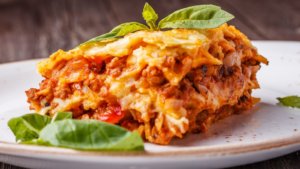
2. Pizza
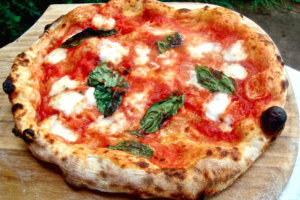
Few foods are as famous around the world as pizza, a true phenomenon! It is one of the most recognizable symbols of Italy around the globe and an important part of the Italian and Neapolitan cultures. But have you ever wondered what the history of this delight is?
Pizza has an ancient history! After the discovery of fermentation by the Egyptians, each people began to develop their own type of bread, including the Romans. They started to make a kind of flat, round bread; a very, very old relative of today’s pizza. Over the centuries, that bread spreads throughout the territory of present-day Italy and begins to be called “pizo”, or “pissa”. But the first record of the word “pizza” comes only on year one thousand.
But wait! That was still not the pizza we love today. The round dough born in Rome had to arrive in Naples to start being what it is today. There, it gains spices such as garlic, salt, oil and cheeses, and aromatic herbs. With the arrival and popularization of tomatoes in Italian cuisine, there is now the missing ingredient. Pizza is now born, one of the most incredible traditional Italian foods of all time.
Neapolitan pizza is so important in Italian culture and cuisine that since 2017 it has been considered a cultural heritage site by UNESCO. Furthermore, there even is an organization to guarantee the quality and tradition of authentic Neapolitan pizza around the world: the Associazione Verace Pizza Napoletana. We were definitely not kidding when we said that food in Italy is taken seriously!
3. Gelato

Gelato is, without a doubt, the most beloved Italian sweet in the world! In addition to being delicious, it is another traditional Italian food full of stories.
People have had the habit of mixing snow with milk, honey or fruit since antiquity. But it is in Sicily, during the Arab domination, that the true origins of gelato lie. Around this time, fruit juices and sugar began to be mixed with snow coming from Mount Etna. Thus were born granita and sorbet, ancestors of Italian gelato. There were even “nivaroli”, workers specialized in collecting snow and storing it in caves for use in the summer.
The fame of these Sicilian sweets then came to Florence, the capital of the Renaissance and city of the powerful. There, this dessert became even more popular, and people developed new ways of storing and conserving ice.
But gelato itself was only born in the 1660s, again with the participation of Sicily. At this time, the Sicilian chef Francesco Procopio de ‘Coltelli inherited a curious machine for making sorbet and granita from his grandfather. Delighted with the results, he moved to Paris in 1660 and founded the mythical Café Procope. There, he added milk to his ice cream recipes, combining it with the unmistakable flavors of Sicily: pistachios, almonds, lemons, oranges, but also chocolate and coffee.
The famous Italian gelato was now born! The new dessert was so successful that Procope received King Sol’s hands, Louis XIV, a special license to produce those frozen delights. Who knew there could be so much history behind one of the most famous traditional Italian foods?

4. Cacio e Pepe
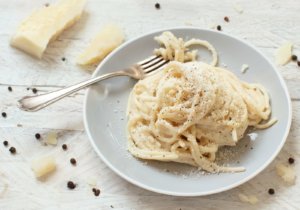
Cacio e pepe (cheese and pepper) is one of Rome’s most significant gastronomic symbols. But what makes this (apparently) simple dish one of the best traditional Italian foods?
First, the simplicity of its ingredients. Cacio e pepe takes only pasta, pecorino cheese, and pepper. However, following the correct preparation, these three items can lead to a wonderful dish, proof that cooking does not always need to be complex to be brilliant.
Second, its history. Cacio e pepe is a true Roman institution, and its origins are linked to the rural roots of Rome. In ancient times, when Roman shepherds needed to take herds from one pasture to another over long distances, they brought with them food that was at the same time caloric, easy to transport and with good durability. That is why they always had dried meat and tomatoes, pepper, cheese, and a little dry pasta.
But there is a reason behind the choice for those three last ingredients. Black pepper directly stimulated heat receptors and helped shepherds protect themselves from the cold. Aged pecorino could be preserved for a long time. Lastly, pasta provided an adequate amount of carbohydrates and calories.
Over time, this mixture spread to the fields of Lazio and neighboring regions, leading to the emergence of cacio and pepe. In short: it is thanks to the ancient Roman shepherds that today we have this delicious traditional Italian food!
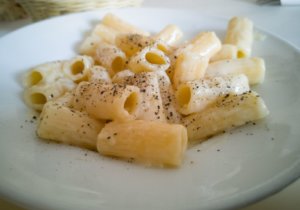
Finally, a curiosity: today cacio e pepe is served very creamy. But legends say that, in the past, taverns served it dry. The reason? To help with the sale of wine. After all, the more cheese and pepper customers ate, the more they had to drink
5. Tiramisù

Light, creamy, smooth, and with a delicious touch of coffee. That is tiramisù, one of the most popular sweets in all of Italy. At the same time, it is also one of the best-known and most loved traditional Italian foods globally. But did you know that, unlike other dishes on this list, tiramisù has a reasonably recent history?
Tiramisù was born in the 1970s in Treviso, and its history shows how the habits of a people can influence the country’s cuisine.
That’s because behind the current tiramisù is the habit of people in the region to consume batudin, a kind of cool drink made from egg yolks and sugar. Local peasant families widely used batudin as an energy tonic for newlyweds, children, the elderly, and convalescents.
Along with batudin, people also consumed whipped cream and dry biscuits called baicoli. Pastry chefs begin to assimilated the habit and, with time, the current tiramisù was born. According to gastronome Giuseppe Maffioli, it was chef Loly Linguanotto who finished the alchemy, officially creating tiramisù at the Alle Beccherie restaurant.
A fun fact: the name of this delicious traditional Italian food comes from “tirame su” (something like “lift me” or “pull me up”), a reference to the energy capacities of the original sweet.
6. Bistecca all fiorentina
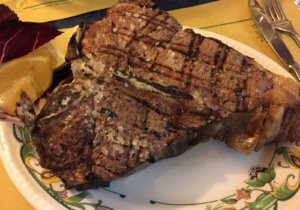
There is also a place for carnivores in our list of traditional Italian foods! If you’ve ever been to a typical restaurant in Florence, you have probably been amazed to see a huge, juicy piece of meat served.
It was probably a bistecca alla fiorentina, a classic of Tuscan cuisine and one of the iconic traditional Italian foods. In other words, it is a large steak with about 2,2lbs to 3,3lbs and about 2 inches thick, exposed to heat only for a few minutes. It is, therefore, serverd very tender and rare. In addition, the traditional Fiorentina is a steak that from “chianina” breed, typical of Tuscany.
The origins of bistecca alla fiorentina are very ancient and are linked to the history of Florence. Legend has it that when the Medici ruled the city (between the 15th and 17th centuries), rulers celebrated San Lorenzo Day, August 10th, with huge bonfires in the city squares.
In them, meat was roasted with wine, later served to the people. The feast, of course, was much anticipated by everyone throughout the year. It was so important that it became a symbol of Florence traditions.
Finally, the origin of word “bistecca”. Legend also says that the Anglo-Saxon merchants and aristocrats who visited the San Lorenzo festivities asked for more and more “beaf-steak”. The term was “Italianized” and thus transformed into “bistecca”.
7. Tortellini
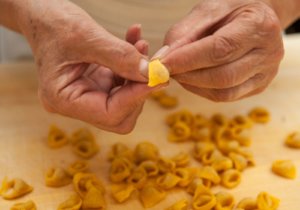
First, if you have never heard of tortellino (plural is tortellini), let us introduce you. It is a pasta filled with meat or ham, with the shape of a belly-bottom. It is a jewel of Emilia Romagna and one of the traditional Italian foods with a surprising history!
Like many Italian dishes, tortellini has its origins disputed by two cities. In this case, we are talking about Bologna and Modena, where it is a gastronomic classic and part of affectionate memories and family traditions.
Tortellini was probably created as a way to reuse leftover roasts from the wealthier. Actually, this is the root of many dishes with ancient roots and family traditions. However, as Italy is indeed a country full of stories, there are different legends and myths about the origin of tortellini.
The main one is that it all started in the battle of Zappolino, in the 1300s, between Modena and Bologna. While waiting for the action, the gods who accompanied the Modenese (including the goddess Venus) stopped to rest at an inn in Castelfranco Emilia. The innkeeper (who was from Bologna) peeked through the lock and saw Venus naked. Enchanted by the grace of her belly-bottom, the man, who was also a cook, immediately decided to immortalize such beauty, giving shape to the tortellino.
Disputes and legends aside, tortellini is one of the most iconic traditional Italian foods. Proof of this is that even the award-winning chef Massimo Bottura, from Modena, is a fan of tortellini and offers a version of the dish at his 3-star Michelin restaurant, Osteria Francescana.
How about a trip to Italy to taste these and other traditional Italian foods?
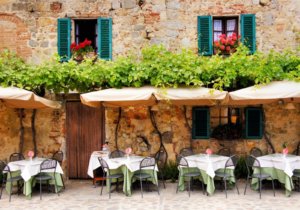
We hope we helped you learn a little more about some iconic traditional Italian foods and their stories. After all, gastronomy is one of the biggest reasons to get to know a country, especially Italy. It is a country full of stories, which invites us to dream of unforgettable trips, plenty of unique flavors! By the way… what stories do you want to live in Italy?
If your mouth watered and you’re feeling inspired to travel, why not plan your trip to Italy now? Talk to us; our team of experts in Italy is at your disposal to create the perfect personalized itinerary, including the best Italian restaurants and gastronomic experiences.
 English
English

